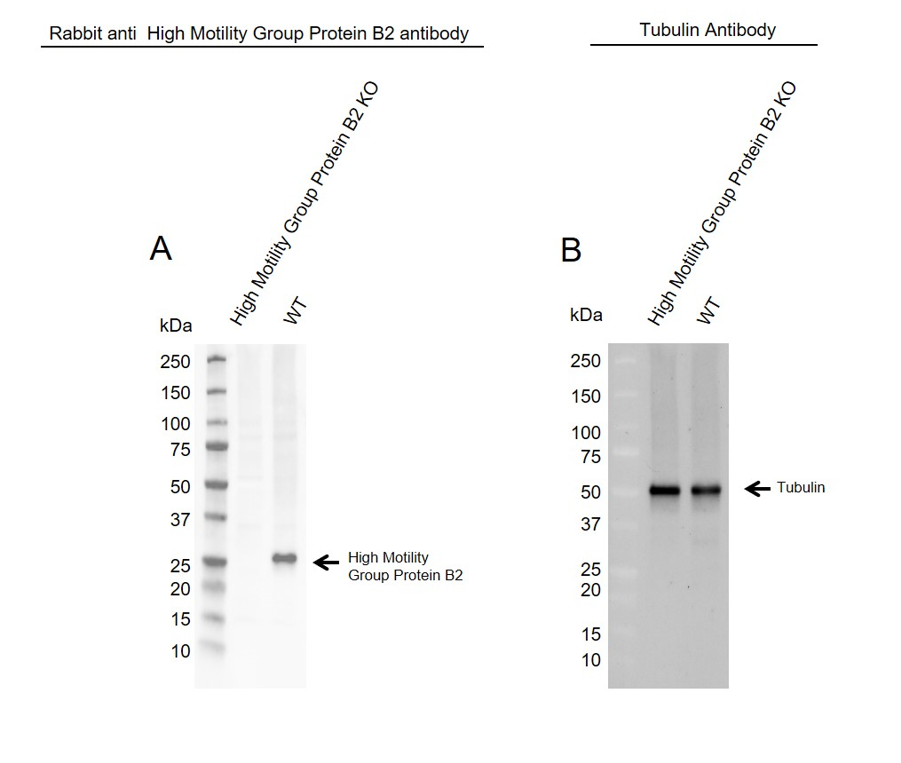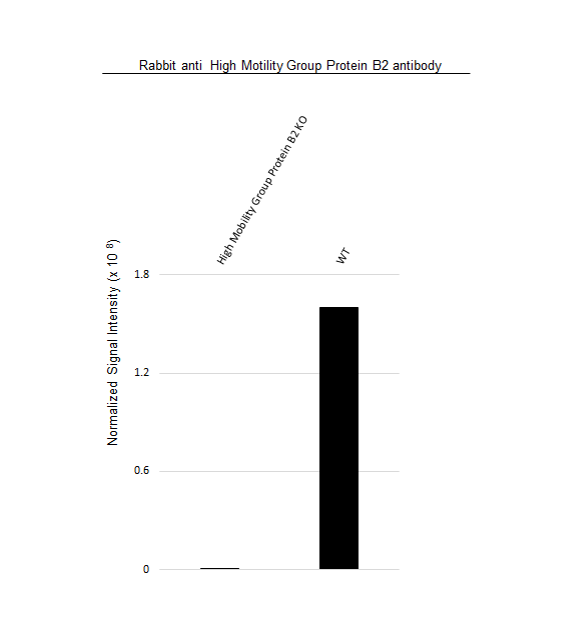High Mobility Group Protein B2 antibody


Rabbit anti High Mobility Group Protein B2
- Product Type
- PrecisionAb Polyclonal
- Isotype
- Polyclonal IgG
- Format
- Purified
- Specificity
- High Mobility Group Protein B2
| Rabbit anti Human high mobility group protein B2 antibody recognizes high mobility group protein B2, also known as HMG-2, high mobility group protein 2, high-mobility group (non-histone chromosomal) protein 2 or high-mobility group box 2. HMG-2 gene encodes a member of the non-histone chromosomal high mobility group protein family. The proteins of this family are chromatin-associated and ubiquitously distributed in the nucleus of higher eukaryotic cells. In vitro HMG-2 is able to efficiently bend DNA and form DNA circles (Paull et al. 1993) suggesting a role in facilitating cooperative interactions between cis-acting proteins by promoting DNA flexibility. HMG-B2 is involved in the final ligation step in DNA end-joining processes of DNA double-strand breaks repair and V(D)J recombination (Nagaki et al. 1998) . Rabbit anti Human high mobility group protein B2 antibody detects a band of 28 kDa. The antibody has been extensively validated for western blotting using whole cell lysates. |

|
- Target Species
- Human
- Western Blotting
- Anti high mobility group protein B2 detects a band of approximately 28 kDa in HEK293 cell lysates.
- Species Cross-Reactivity
-
Target Species Cross Reactivity Mouse - N.B. Antibody reactivity and working conditions may vary between species.
- Product Form
- Purified IgG - liquid.
- Preparation
- Rabbit polyclonal antibody purified by affinity chromatography.
- Buffer Solution
- Phosphate buffered saline.
- Preservative Stabilisers
- 0.09% Sodium Azide (NaN3)
2% Sucrose. - Immunogen
- Synthetic peptide directed towards the C terminal region of human high mobility group protein B2
- Approx. Protein Concentrations
- IgG concentration 0.5 mg/ml.
- Regulatory
- For research purposes only.
- Guarantee
- 12 months from date of despatch.
- Acknowledgements
- PrecisionAb is a trademark of Bio-Rad Laboratories.
| Application Name | Verified | Min Dilution | Max Dilution |
|---|---|---|---|
| Western Blotting | 1/1000 |
| Description | Product Code | Applications | Pack Size | List Price | Your Price | Quantity | |
|---|---|---|---|---|---|---|---|
| Goat anti Rabbit IgG (H/L):HRP | STAR208P | WB | 2 ml |
|
Log in | ||
| List Price | Your Price | ||||||
|
|
Log in | ||||||
| Description | Goat anti Rabbit IgG (H/L):HRP | ||||||
- UniProt
- P26583
- Entrez Gene
- HMGB2
- GO Terms
- GO:0000793 condensed chromosome
- GO:0001938 positive regulation of endothelial cell proliferation
- GO:0003684 damaged DNA binding
- GO:0003690 double-stranded DNA binding
- GO:0003697 single-stranded DNA binding
- GO:0003700 sequence-specific DNA binding transcription factor activity
- GO:0006334 nucleosome assembly
- GO:0005615 extracellular space
- GO:0005654 nucleoplasm
- View More GO Terms
- GO:0005730 nucleolus
- GO:0006265 DNA topological change
- GO:0006288 base-excision repair, DNA ligation
- GO:0006309 DNA fragmentation involved in apoptotic nuclear change
- GO:0008301 DNA bending activity
- GO:0010843 promoter binding
- GO:0016563 transcription activator activity
- GO:0016565 general transcriptional repressor activity
- GO:0048015 phosphatidylinositol-mediated signaling
- GO:0032075 positive regulation of nuclease activity
- GO:0033151 V(D)J recombination
- GO:0042056 chemoattractant activity
- GO:0043234 protein complex
- GO:0043388 positive regulation of DNA binding
- GO:0045648 positive regulation of erythrocyte differentiation
- GO:0045654 positive regulation of megakaryocyte differentiation
- GO:0048471 perinuclear region of cytoplasm
- GO:0050786 RAGE receptor binding
- GO:0060326 cell chemotaxis
- GO:0071222 cellular response to lipopolysaccharide
VPA00494
If you cannot find the batch/lot you are looking for please contact our technical support team for assistance.
Please Note: All Products are "FOR RESEARCH PURPOSES ONLY"
View all Anti-Human ProductsAlways be the first to know.
When we launch new products and resources to help you achieve more in the lab.
Yes, sign me up
